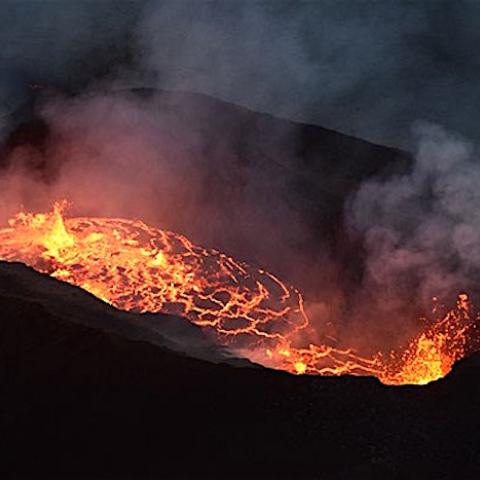
Lava fountains during the 1959 Kīlauea Iki eruption (upper left), 1969 Maunulu eruption (upper right), 1983 Puʻuʻōʻō eruption (lower left), and the ongoing summit eruption in Halemaʻumaʻu (lower right)/USGS
Editor's note: Volcano Watch is a weekly article and activity update written by U.S. Geological Survey Hawaiian Volcano Observatory scientists and affiliates.
Kīlauea volcano at Hawai'i Volcanoes National Park is in a unique phase of activity in Halemaʻumaʻu, with 12 episodes of dual lava fountains since December 23, 2024. Several past eruptions have been characterized by similar lava fountaining episodes, including at the start of the Puʻuʻōʻō eruption in 1983, the start of the Maunaulu eruption in 1969, and the 1959 Kīlauea Iki eruption.
Even more recently, fissure 8 of the 2018 lower East Rift Zone eruption exhibited a continuous lava fountain for over two months. However, the lava fountain at fissure 8 differed from episodic lava fountains occurring recently at Kīlauea summit. The continuous fissure 8 lava fountains were primarily driven by a pressure gradient as magma moved from storage chambers beneath the summit to erupt out of the low-elevation vent on the flank of the volcano.
Episodic lava fountains are driven by changes in pressurization, related to new magma being supplied. As new magma accumulates, the amount of pressure builds. Eventually, lava erupts and de-pressurizes the system. As magma rises to the surface, magmatic gas rapidly exsolves as bubbles—just like when you open a bottle of soda or champagne. This gas is a major driving force of the lava fountaining, and the pieces of lava found around the crater rim are filled with bubbles, resembling a stiff foam.
Many people remember the 1983–2018 middle East Rift Zone of eruption of Puʻuʻōʻō for the accessible lava flows on the coastal plain and ocean entries. But the first three years of the Puʻuʻōʻō eruption were characterized by 44 lava fountaining episodes that built a prominent cinder- and spatter-cone standing 835 feet (255 meters) above the surrounding landscape. Lava fountaining episodes during this eruption occurred every 3–4 weeks and lasted about a day. Reaching heights up to 1,500 feet (460 meters), the lava fountains fed lava flows that traveled downslope. Some of the lava flows reached the Royal Gardens subdivision and destroyed several houses.
At the start of the 1969–1974 Maunaulu eruption, 12 lava fountaining episodes occurred in the upper East Rift Zone. Each lava fountaining episode generally lasted for several hours, slowly building in height until a maximum height was reached, after which the fountains died within minutes. Fountains from Maunaulu reached up to 1,770 feet (540 meters). Lava flows fed by Maunaulu fountains traveled downslope, once going more than 12 miles (7.5 kilometers) to eventually enter the ocean.
The short but spectacular Kīlauea Iki eruption occurred in the crater just northeast of Kaluapele, the summit caldera. From November 14 to December 20, 1959, there were 17 episodes of lava fountaining that filled in the Kīlauea Iki Crater with 440 feet (135 meters) of lava. The longest episode was six days and episode 15 of the eruption included the highest lava fountains yet measured on Kīlauea, reaching staggering heights of 1,900 feet (580 meters). These high lava fountains built the prominent Puʻupuaʻi cinder cone, which you can view on the Devastation Trail in Hawaiʻi Volcanoes National Park.
Hazards associated with lava fountaining include the fallout materials (termed tephra), volcanic gas emissions, and lava flows. Tephra generally accumulates in the area immediately downwind of the vent and can build features such as cinder cones. Changes in wind direction and speeds can result in these particles being wafted greater distances to impact nearby communities. Like all eruptions, increased volcanic gas emissions associated with lava fountains creates volcanic air pollution (vog), which affects regions downwind. When lava fountain events occur on the flanks, they feed lava flows that travel downslope, and destroy everything in their path.
The ongoing eruption is occurring within Halemaʻumaʻu, with lava flows contained in the summit caldera. Trade winds transport tephra and gas emissions to the southwest, away from the closest communities, but changes in wind conditions may result in Pele’s Hair and vog in areas that include Hawaiʻi Volcanoes National Park and nearby communities.
Lava fountains in the ongoing Kīlauea summit eruption haven’t reached “high” fountain heights of over 1,000 feet (305 meters). So far, there have been 12 episodes of lava fountaining in the ongoing Kīlauea summit eruption—the same number as Maunaulu. Continuing inflation suggests this eruption will likely continue, but whether it catches up to Kīlauea Iki or Puʻuʻōʻō, in terms of the number of episodes or fountain heights, remains to be seen.




 Support Essential Coverage of Essential Places
Support Essential Coverage of Essential Places






